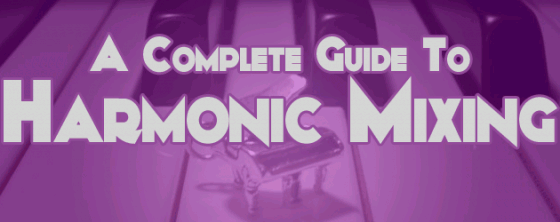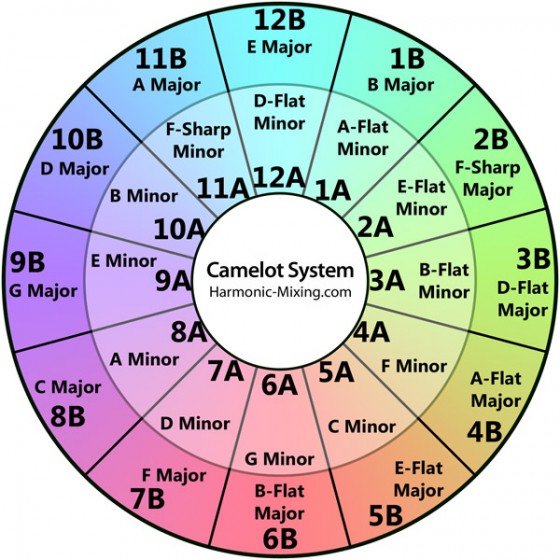
Harmonic mixing is a strategy employed by all professional DJs, producers, and musicians, to compose songs, mashups, and mixes that are pleasing to listen to. When the rules of harmonics are broken, compositions sound “sour” or off, but when the rules are followed a composition (a mix, a mashup, or just an individual song) will sound louder, clearer, and “sweeter”. This article is aimed at those with little to no music theory background, to provide a brief explanation as to why this occurs, and offer a strategy for DJs and mashup producers that is rapidly deployable (read: you can put what you learn in this article to work immediately, without delay!)
Some Science – Sound Is Energy
In case you’re not already aware, sound travels in waves. As these waves travel through a physical space they cause vibrations, and it is because of this property that we define sound as mechanical energy (if you think back to high school physics, the work performed – the energy – is equal to force * distance). So if one piece of music played at a certain volume has one amount of energy – say x, and a second has another amount of energy – we’ll call this y, the total amount of energy should be x + y right? Wrong! While it’s true that there is an additive effect when you put two musical elements together, you don’t get the entire sum of energy because some interference always occurs.
This interference – something called dissonance – varies depending on how compatible the musical elements are. There are several measures of musical compatibility, one of which is the key. While this applies generally to music, for example putting vocals or drums together with a rhythm, the rest of this article will focus specifically on putting two songs together, either in a mashup or DJ mix.
Crafting a Perfect Mix or Mashup
Of the fundamental elements to DJ’ing (song selection/programming, volume control/EQ’ing, and mixing) I would argue that the the mix is the most powerful – even the untrained DJ will notice that when two songs are mixed together well the energy in the room spikes. Harmonic mixing is a technique that allows songs to be mixed and mashed for longer periods, can conceal the fact that songs are even being mixed, and optimizes the total amount of sound energy created by putting two tracks together. Two songs that are harmonically compatible will have more energy than two that aren’t – the result is an increase in the ‘perceived loudness’ of the energy coming from the speakers, and the effect on your audience is a more exciting mix/portion of your set. Take notice of this – when you start playing a portion of a second song with the first, if you’re listening hard enough you can almost always hear your audience go “woooh!”
There are really two ways to figure out if songs are harmonically compatible – learn music theory, or use Mark Davis’ Camelot System (covered below). Before you can do so, you have to actually determine the key of the song – you can do this by testing the key of the song yourself with an instrument, or by using the computer program I use. This program, called MixedInKey, allows me to drag and drop batches of files straight from my Serato Crates, iTunes, or from a folder on my computer, and determines the key of the song for me.
Determining Harmonic Compatibility Using the Camelot System
MixedInKey makes Harmonic Mixing trivially easy, and the Camelot System that it relies on is a fool-proof way of determining Harmonic Compatibility that is simple enough to be used on the fly in a night club. It requires no effort and no knowledge of music theory.
Once my files have been analyzed by the MixedInKey program, a Camelot code is added to the id3 information by MixedInKey that can be read by iTunes, Serato, and other DJ’ing programs. This code corresponds to the Camelot Wheel which is unnecessary to memorize – all you need to remember is the very simple principle underlying it.
The principle is simple – think of the wheel like a clock, and move one hour ahead or behind (or stay at the same time). If your song has a code 6A, you can move to 5A or 7A, or you can stay at 6A. There are two wheels – an A wheel and B wheel. You can move between A and B in the same hour – ie from 6A to 6B – but you can’t change time – ie from 8A to 9B.
Here’s the Camelot Wheel:

To learn more about MixedInKey, or to purchase it online check this link. I am an affiliate, so I will earn a small amount of money if you do decide to buy, but do so knowing that I would never recommend the product if I didn’t really and truly believe in it. MixedInKey has become completely indispensable to my DJ’ing, and I would find it hard to do without.